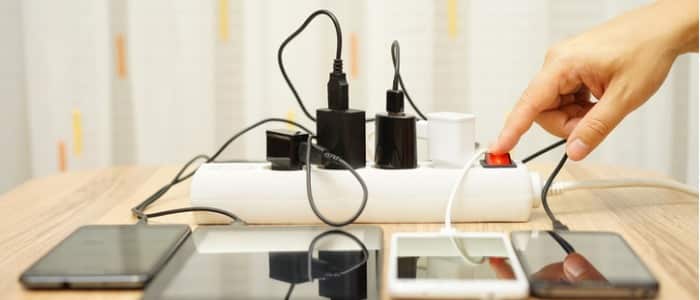
What is a Power Surge?
A power surge always happens at the worst time, because no time is good to have a power surge. We are so heavily reliant on reliable energy that even an hour without electricity can become a major hassle.
Power surges are related to the flow of electricity into your home. The electricity going to your outlets is typically around 120 volts, although it fluctuates between 0 and 169 volts. When it exceeds 169 volts, that’s when a power surge occurs.
The trick to handling power surges is knowing why they happen and what can be done to protect your home when the electrical flow gets out of control.
Why Power Surges Happen
There are several reasons why power surges happen. Some of the most common reasons are:
- The utility provider does a power grid switch.
- A transmission line or transformer malfunctions.
- Storms and lightning strikes.
Another major factor that can cause power surges is the overloading of an electrical system.
Electrical overloads occur when too much electricity is pulled from a single circuit, as the name implies. This occurs when using several extension cables on a single outlet or plugging in several devices with high voltages that have high current circuits.
Smaller power surges can also happen within a home (internal power surge). They’re actually more common than power surges caused by outside forces (external power surge). Surges within the home are usually due to large systems like the HVAC unit. They can cause a small power surge when they turn on or off because they require so much electricity. This type of power surge only lasts a second, and you probably won’t notice it.
One thing to also watch out for is power surges after an outage. It’s not uncommon for a power surge to happen whenever the power finally comes back on. That’s why experts recommend unplugging appliances and electronics when the power goes out.
What are the signs of a power surge?
Some signs include clocks, lights or electronic devices flashing. Or when they are completely turned off or not even working. There might also be an unpleasant burnt odor smell near the electronic pieces of equipment.
The Different Types of Power Surges
Internal and external power surges are the two forms of power surges.
Internal Power Surge
These occur periodically and make up a large percentage of all power surges. They frequently occur because of motors switching on and off, causing electricity to overflow to other household items. Fridges and air conditioning systems are the most common causes, although hairdryers and machine tools also contribute.
External Power Surge
Lightning strikes, a tiny animal getting stuck into a transformer, a tree branch falling on an electricity wire are examples of external forces that cause external power surges.
A Word About Brownouts
In the summer, something called brownouts can happen. This is a planned reduction in electricity service in an effort to meet energy demands, not an actual power surge. For more on this topic, check out our tips for handling summer brownouts.
Two Ways to Prevent Power Surge Damage
Surge protection is something everyone should take seriously. Power surges can be so strong they can damage appliances, devices, and electronics that are plugged in. The damage occurs because the equipment is designed to handle only so much electricity. When the voltage spikes above the operational limit an arc of electrical current generates heat that damages internal components.
Quite literally, the device or appliance is fried. It can happen instantly after a big power surge or overtime from incremental damage during small surges. Luckily, there are a few solutions that can prevent power surge damage.
How to protect home equipment against power surges?
Surge protective devices are by far the most common approach (SPDs). The SPDs restrict sudden overvoltage from entering the device, saving it from being damaged. They also redirect the electricity to a different path, into the ground, and thereby keep the extra voltage away from the electronic device. The SPDs have two major operational modes, each of which allows for the flow of current.
Again, the SPD redirects the surge to the ground wire instead of suppressing it. Surge protective devices can indeed be built into the power supply and connected to a power outlet via a surge-protected connector, extension power strips, or automated voltage monitors.
Whole House Surge Protector
Whole house surge protectors are great for large external power surges. The surge protector is installed at the fuse box to stop the power surge before it goes inside.
A whole-house surge protector comes in a range of power capacities. The greater the power capacity (in joules) the more expensive it will be. You can find whole house surge protectors for as little as $50, but many protectors will cost $100 or more.
Plug-In Surge Protector Power Strips
A less expensive option is surge protector power strips. Of course, there are a few trade-offs. For starters, a power strip will only protect the appliances and devices that are plugged into it. You also have to make sure the power strip is rated to protect what you’re plugging in. Surge protector power strips are rated in joules and range from 400 to 1,000+ joules.
Spark Energy is here for you during inevitable power surges. Keeping the electricity flowing is the utility’s responsibility, but we can help you get the most reliable energy possible for a predictable fixed rate. Check to see if Spark Energy electricity plans are available in your area.



